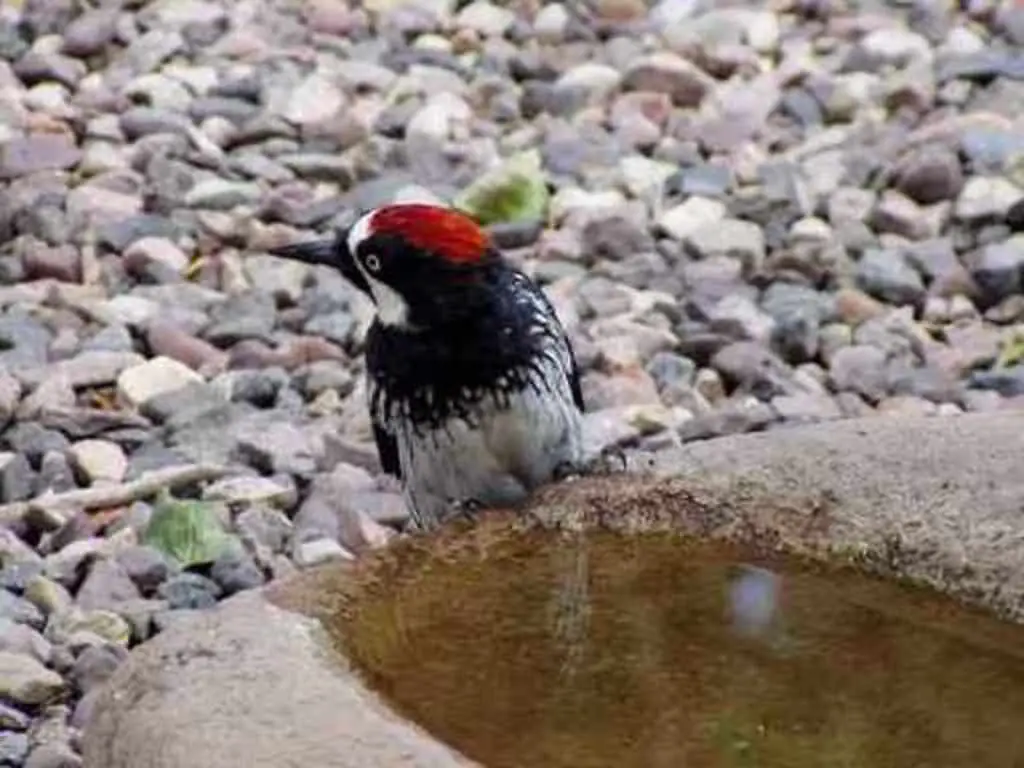Welcome to our expert guide on the 11 types of woodpeckers in New Mexico! From the majestic Gila woodpecker to the vibrant Red-headed woodpecker, New Mexico is home to a diverse array of woodpecker species.
In this comprehensive guide, we’ll explore each species’ unique characteristics, habitats, behaviors, and more, providing valuable insights for bird enthusiasts and nature lovers alike.
Table of Contents
Types of Woodpeckers in New Mexico
Ladder-backed Woodpecker
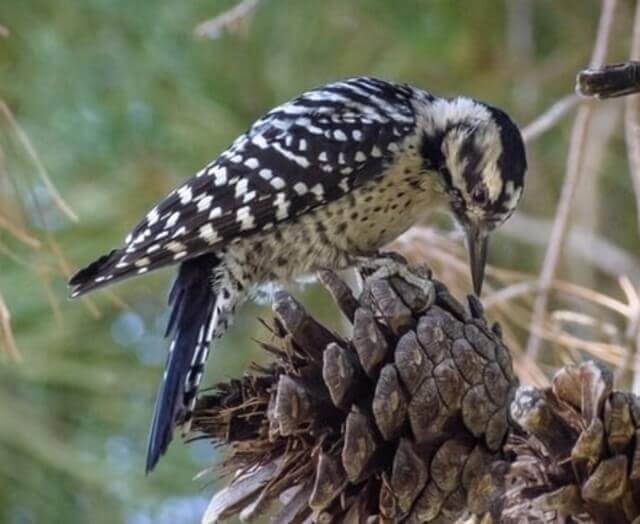
- Length: 6.3-7.1 in (16-18 cm)
- Weight: 0.7-1.7 oz (21-48 g)
- Wingspan: 13.0 in (33 cm)
- Scientific Name: Dryobates scalaris
- Frequency of Occurrence: 11.68% (Statistic by: eBird)
- Maps: Range Map – Sightings Map
- Sounds: Calls and songs
Description: The Ladder-backed Woodpecker is widely distributed across North America. Its range stretches from the southwestern United States to central Mexico, and eastward through most of the eastern USA. The bird prefers habitats that have plenty of tree cavities and open spaces such as pinyon-juniper, scrubland, riparian woodlands and even deserts.
This species feeds mainly on insects that it finds in trees or on the ground, including beetles, ants and grasshoppers. It also occasionally eats berries, fruits and nuts. Nesting occurs mainly in cavities of dead trees, or more rarely in utility poles or artificial nest boxes. The female typically lays 4 to 5 eggs, which are incubated by both parents for 12 to 14 days before hatching.
Hairy Woodpecker
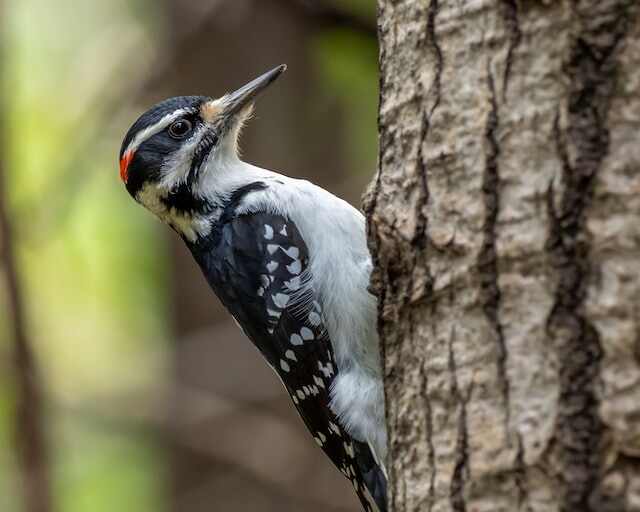
- Length: 7.1-10.2 in (18-26 cm)
- Weight: 1.4-3.4 oz. (40-95 g)
- Wingspan: 13.0-16.1 in (33-41 cm)
- Scientific Name: Picoides villosus
- Frequency of Occurrence: 7.41%
- Maps: Range Map – Sightings Map
- Sounds: Calls and songs
Description: The Hairy Woodpecker is a species of woodpecker found across North America. Its distribution range extends from northern Canada, south to Mexico and includes most of the United States. This hardy bird prefers living in coniferous forests, as well as mixed oak-pine or deciduous woods, but can also be found in urban and suburban areas with large trees.
In terms of food sources, the Hairy Woodpecker feeds mainly on insects such as ants, beetles, caterpillars and spiders, but will also eat fruits like blackberries and cherries during the summer months. It typically nests in cavities created by other birds or by excavating its own hole in dead tree trunks or branches. The female usually lays 4–7 eggs at once, and both parents work together to incubate them for 12 days until they hatch.
Downy Woodpecker
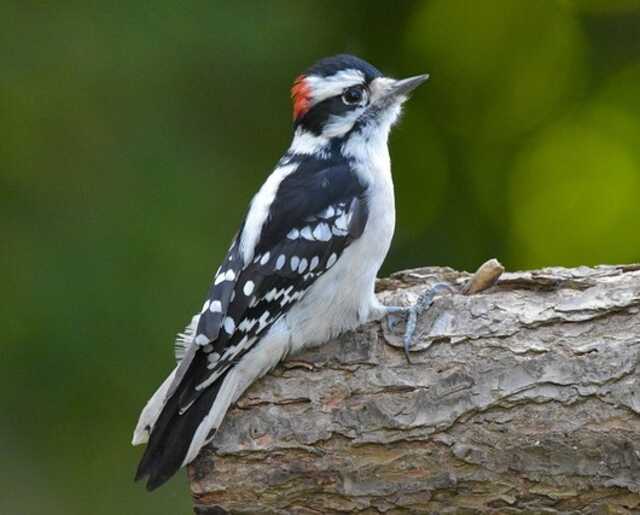
- Length: 5.5-6.7 in (14-17 cm)
- Weight: 0.7-1.0 oz. (21-28 g)
- Wingspan: 9.8-11.8 in (25-30 cm)
- Scientific Name: Picoides pubescens
- Frequency of Occurrence: 6.34%
- Maps: Range Map – Sightings Map
- Sounds: Calls and songs
Description: The Downy Woodpecker, a member of the Picidae family, is one of the most common woodpeckers in North America. These small birds are found throughout Canada and the continental United States, living in deciduous or mixed forests, where they can find plenty of food and shelter. They prefer open areas with trees that offer plenty of insect life, such as dead tree trunks or limbs, fence posts, and other wooden structures. As its name implies, these woodpeckers have a soft down-like texture to their feathers.
Downy Woodpeckers use their strong beak to tap into bark and wood in search of insects like ants and beetles, but will also eat some fruit and nuts during certain times of the year. In winter months, they may visit birdfeeders for suet or seed. Downy Woodpeckers usually nest in cavities that they create in dead trees or even live trees if there is a suitable opening available. The female lays 3-5 white eggs inside while the male takes care of gathering material to build up the walls. Once hatched, young chicks require both parents’ attention until they fledge after about three weeks time.
Read more: How to Attract Downy Woodpeckers to Your Yard? (Easy!)
Acorn Woodpecker
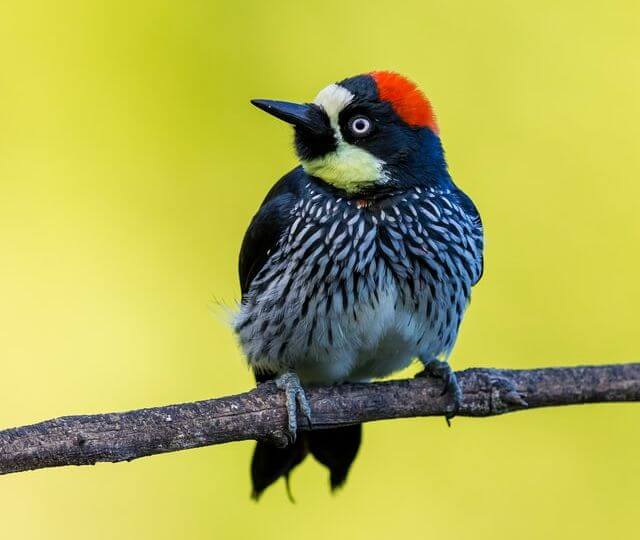
- Length: 7.3-9.4″ in (18.5-24.0 cm)
- Weight: 2.3-3.2 oz. (65-90 g)
- Wingspan: 13.8-17.7 in (35-45 cm)
- Scientific Name: Melanerpes formicivorus
- Frequency of Occurrence: 3.36%
- Maps: Range Map – Sightings Map
- Sounds: Calls and songs
Description: The acorn woodpecker (Melanerpes formicivorus) is an interesting bird that is distributed from central Oregon in the United States to northern Honduras. Its main habitats are open oak or pine forests, but it can also be found in sagebrush or chaparral areas, parks and even urban trees. The primary food source for the acorn woodpecker consists of acorns, insects, fruits, and berries.
They store their surplus of food in cavities they drill into tree trunks and limbs, which also serves as nesting sites during breeding season. Acorn woodpeckers tend to live in colonies known as “graneries” with each bird having its own cavity that it defends against other birds with unique calls and aggressive behavior.
Lewis’s Woodpecker

- Length: 10.2-11.0 in (26-28 cm)
- Weight: 3.1-4.9 oz. (88-138 g)
- Wingspan: 19.3-20.5 in (49-52 cm)
- Scientific Name: Melanerpes lewis
- Frequency of Occurrence: 0.8342%
- Maps: Range Map – Sightings Map
- Sounds: Calls and songs
Description: The Lewis’s Woodpecker (Melanerpes lewis) is a medium-sized woodpecker that inhabits western regions of the United States, Mexico, and parts of Central America. They can be found in Arizona, California, Colorado, New Mexico, Oregon, Texas, Utah and Washington. Their main habitats are open coniferous forests with clearings or meadows near ponderosa pine trees; they sometimes inhabit riparian woodland habitats as well. It is most commonly seen in open scrubby areas along rivers or other water sources where it can find its preferred food source – insects.
The diet consists mainly of beetles and their larvae but also includes ants, caterpillars, grasshoppers and others. Lewis’s Woodpeckers nest in cavities dug out from dead tree limbs or trunks. They will also reuse old nesting sites from previous years. Both male and female will work together to excavate the cavity, which can measure up to 6 inches deep. They line the inside with pieces of bark or other soft material such as mosses or lichens for insulation during breeding season. The nest may be reused by different pairs over several years before being abandoned altogether once the present pair moves on to another location for nesting.
American Three-toad Woodpecker

- Length: 8.3-9.1 in (21-23 cm)
- Weight: 1.6-2.4 oz. (44.8-67.9 g)
- Wingspan: 14.6-15.3 in (37-39 cm)
- Scientific Name: Picoides dorsalis
- Frequency of Occurrence: 0.2661%
- Maps: Range Map – Sightings Map
- Sounds: Calls and songs
Description: The American Three-toad Woodpecker (Melanerpes americanus) is a species of bird belonging to the Picidae family. This woodpecker has a very large distribution range across North, Central and South America. In the United States, it can be found in most states east of the Mississippi River, as well as parts of Texas and Oklahoma. In Canada, its range extends from Manitoba down to Nova Scotia. This species prefers open deciduous and mixed forests with lots of dead trees for nesting sites.
It tends to stick close to woodland edges and can often be seen in backyards and parks that have mature trees nearby. It feeds on insects such as ants and beetles, but they also eat fruits, nuts and berries when available. Their nests are usually made in cavities found near the base of dead or dying trees. They use bark chips to line these cavities before using them for nesting sites; this helps protect their eggs from predators such as snakes and raccoons. The American Three-toad Woodpecker also excavates new nesting cavities if needed.
Gila Woodpecker
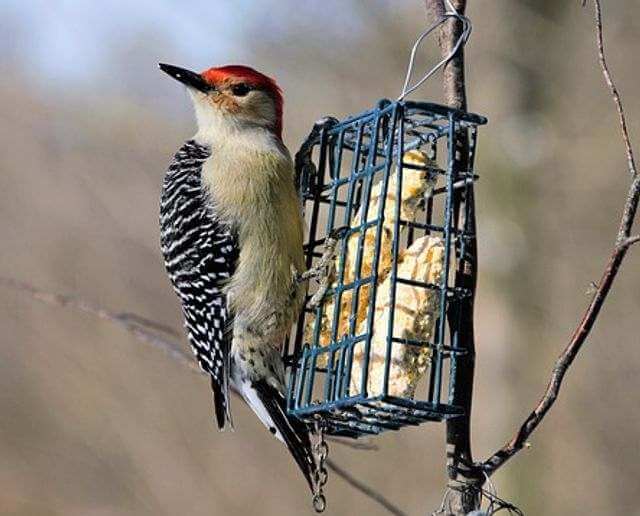
- Length: 8.3-9.8″ in (21-25 cm)
- Weight: 1.8-2.8 oz. (50-80 g)
- Wingspan: 15.7-16.9″ in (40-43 cm)
- Scientific Name: Melanerpes uropygialis
- Frequency of Occurrence: 0.2361%
- Maps: Range Map – Sightings Map
- Sounds: Calls and songs
Description: The Gila Woodpecker is a medium-sized woodpecker native to the desert regions of the southwestern United States and northern Mexico. They are found in semi-arid scrub, pinyon pine-juniper woodlands, open oak woodlands, riparian zones near rivers, and other dry and arid habitats. These birds have a wide distribution range throughout Arizona, New Mexico, western Texas, southeastern California, southern Nevada, and parts of Utah. Gila Woodpeckers primarily feed on insects such as beetles and ants found under the bark of trees or among rocks.
They will also eat fruits such as prickly pear cactus pads and mesquite beans. The birds nest in cavities they create by chiseling away at dead sections of trees or utility poles. They may use existing holes created by other species, such as Northern Flickers or Peregrine Falcons. Their nests are typically lined with grasses or feathers to provide insulation from the extreme temperatures found in their habitat.
Red-headed Woodpecker
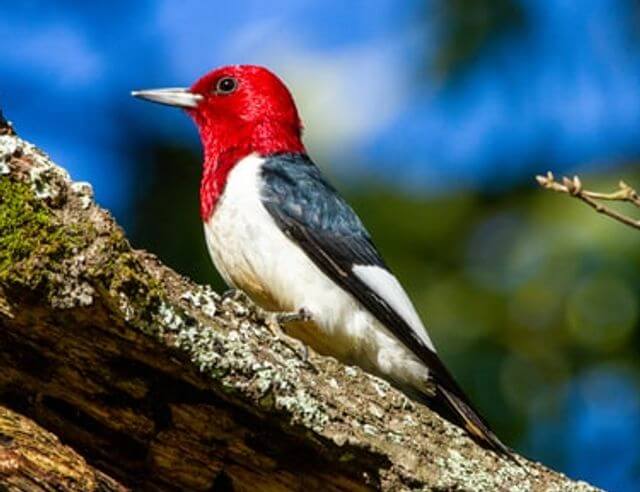
- Length: 7.5-9.1 in (19-23 cm)
- Weight: 2.0-3.2 oz. (56-91 g)
- Wingspan: 16.5 in (42 cm)
- Scientific Name: Melanerpes erythrocephalus
- Frequency of Occurrence: 0.2260%
- Maps: Range Map – Sightings Map
- Sounds: Calls and songs
Description: The Red-headed Woodpecker is a striking species of bird, recognized for its bright red head and black and white body. It has an extensive range that extends from the east coast of North America to the Rocky Mountains, as well as parts of Mexico, Central America, and the Caribbean. The Red-headed Woodpecker is generally resident in its range, but may migrate short distances in response to food availability or weather changes. In natural settings, the Red-headed Woodpecker prefers forests with open canopies, old fields, orchards, and other habitats where trees are interspersed with grassy areas.
This species also shows up at backyard feeders in some areas. Its diet consists mainly of insects such as beetles, caterpillars, ants, bees, wasps, bugs, scales and aphids; it will also eat tree sap, berries and nuts if available. Nesting activities typically occur between April and July, depending on location. Both sexes help excavate a nesting cavity high up in a dead tree or standing dead limb.
Read more: Interesting Red-Headed Woodpecker Facts (Explained)
Arizona Woodpecker

- Length: 7.0-7.9 in (17.8-20.3 cm)
- Weight: 1.2-1.8 oz. (34-51 g)
- Wingspan: 13.8-14.2″ in (35.1-36.1 cm)
- Scientific Name: Picoides arizonae
- Frequency of Occurrence: 0.0697%
- Maps: Range Map – Sightings Map
- Sounds: Calls and songs
Description: The Arizona Woodpecker is a colorful species of woodpecker native to the mountains and foothills of the southwestern United States. This drab-colored bird can be found in mountain pine forests between 5,000 and 10,000 feet in elevation. It also inhabits open ponderosa pine and pinyon-juniper woodlands. Arizona Woodpeckers eat mainly insects such as beetles and grasshoppers by drilling holes into trees or hammering on dead branches. They also feed on fruits, nuts, seeds, and sap from trees.
Nests are constructed by excavating cavities in the trunk or limbs of a dead or dying tree; they prefer to nest in conifers with rough bark that is easier to tunnel into. The birds tend to be solitary during breeding season, but may form small groups during migration. This species is widespread throughout its range, but is considered vulnerable due to habitat loss resulting from urban sprawl and logging activities.
Red-bellied Woodpecker

- Length: 9.5 in (24 cm)
- Weight: 2.0-3.2 oz. (56-90 g)
- Wingspan: 13.0-16.5 in (33-42 cm)
- Scientific Name: Melanerpes carolinus
- Frequency of Occurrence: 0.0210%
- Maps: Range Map – Sightings Map
- Sounds: Calls and songs
Description: The Red-bellied Woodpecker is a species of woodpecker primarily found in the eastern half of North America. Their distribution range extends from southeastern Canada to northern Florida and Gulf Coast states, as well as parts of Mexico and Central America. These birds inhabit deciduous woodlands, savannas, agricultural lands, residential areas and parks. They feed mainly on insects such as beetles, ants and caterpillars that are found under bark or inside decaying trees.
They will also eat nuts, fruits and berries when available. During the nesting season, they create cavity nests in dead trees or utility poles. The female will lay anywhere between 3–8 white eggs per clutch, and both parents will cooperate in incubating them for nearly 2 weeks before the chicks hatch. After fledging the nest after three weeks or so, the young ones will remain with their parents until they become independent at around 6–8 weeks old.
Read more: How to Attract Red-bellied Woodpeckers to your Yard?
Golden-fronted Woodpecker
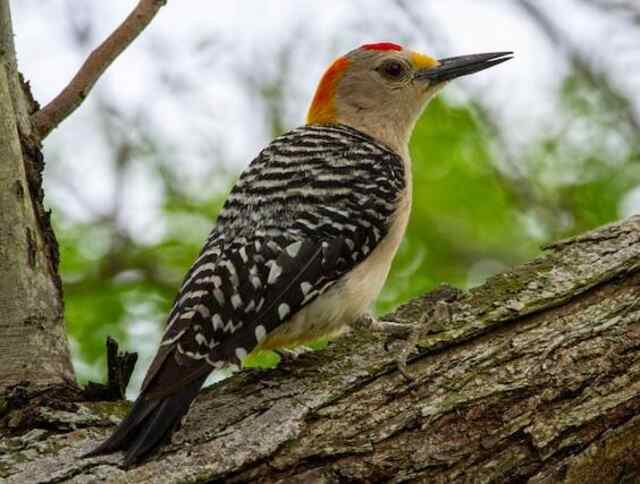
- Length: 8.7-10.2 in (22-26 cm)
- Weight: 2.6-3.5 oz (73-99 g)
- Wingspan: 16.5-17.3 in (42-44 cm)
- Scientific Name: Melanerpes aurifrons
- Frequency of Occurrence: 0.0038%
- Maps: Range Map – Sightings Map
- Sounds: Calls and songs
Description: The Golden-fronted Woodpecker (Melanerpes aurifrons) is a medium-sized native to the western United States and Mexico. In Arizona, this species is found in the lower Sonoran Desert, from central and southern Arizona, through New Mexico and Texas to California. This woodpecker inhabits brushy deserts, riparian canyons, mesquite bosques and edge habitats with plenty of trees or snags where they can feed and nest.
They primarily feed on insects such as beetles, but will occasionally eat fruits, nuts and seeds. During nesting season, they will excavate cavities in dead branches or trunks for their nests. The female bird will lay two to eight white eggs that are incubated for about 11 days before hatching into young chicks. The parents will continue to look after them until they fledge from the nest at 24 – 28 days old.

